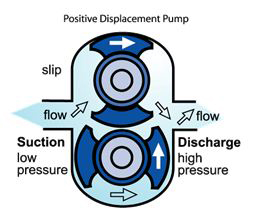Pumps are available in a variety of sizes for a wide range of applications. They can be classified according to their basic operating principle as dynamic or displacement pumps. Dynamic pumps can be sub-classified as centrifugal and special effect pumps. Displacement pumps can be sub-classified as rotary or reciprocating pumps. Where different pump designs could be used, the centrifugal pump is generally the most economical followed by rotary and reciprocating pumps. Although, positive displacement pumps are generally more efficient than centrifugal pumps, the benefit of higher efficiency tends to be offset by increased maintenance costs. Worldwide, centrifugal pumps account for the majority of electricity used by pumps.
Electricity is the main energy type used for operation of pumps.
Design & Operation
In process operations, liquids and their movement and transfer from place to place, plays a large part in the process. Liquid can only flow under its own power from one elevation to a lower elevation or, from a high pressure system to a lower pressure system. To keep pumps operating successfully for long periods of time, several elements are required. These elements include careful pump design selection; proper installation; careful operation; the ability to observe changes in performance over time; and, in the event of a failure, the capacity to thoroughly investigate the cause of the failure and take measures to prevent the problem from recurring. Pumps that are properly sized and dynamically balanced; that sit on stable foundations with good shaft alignment and with proper lubrication; that operators start, run, and stop carefully; and that maintenance personnel observe for the appearance of unhealthy trends, usually never experience a catastrophic failure.
Types of Pump
Pumps come in many types and sizes. The type depends on the function the pump is to perform and the size (and speed) depends on the amount (volume) of liquid to be moved in a given time. However most pumps fall into two main categories.
- Centrifugal pumps
- Positive displacement pumps
Centrifugal Pumps
A centrifugal pump is of a very simple design. The two main parts of the pump are the impeller and the diffuser. Impeller, which is the only moving part, is attached to a shaft and driven by a motor. Impellers are generally made of bronze, polycarbonate, cast iron, stainless steel as well as other materials. The diffuser (also called as volute) houses the impeller and captures and directs the water off the impeller.

Modern process plants use powerful centrifugal pumps, primarily because of the following factors :
- The low initial cost.
- Low maintenance costs.
- Simple in operation.
- Ability to operate under a wide variety of conditions.
- Give a smooth, continuous flow, free from pulsation.
Positive Displacement Pumps

A positive displacement pump has an expanding cavity on the suction side of the pump and a decreasing cavity on the discharge side. Liquid is allowed to flow into the pump as the cavity on the suction side expands and the liquid is forced out of the discharge as the cavity collapses. This principle applies to all types of positive displacement pumps whether the pump is a rotary lobe, gear within a gear, piston, diaphragm, screw, progressing cavity, etc. A positive displacement pump, unlike a centrifugal pump, will produce the same flow at a given rpm no matter what the discharge pressure is



